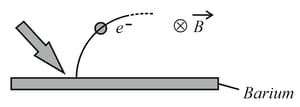EASY
Physics
IMPORTANT
Earn 100
Ultraviolet radiation of 6.2 eV falls on an aluminium surface (work function 4.2 eV). The kinetic energy of the fastest electron emitted is approximately
(a) J
(b) J
(c) J
(d) J
87.5% studentsanswered this correctly

Important Questions on Dual Nature of Matter and Radiation
HARD
Physics
IMPORTANT
Light of wavelength is incident on barium. Photoelectrons emitted describe a circle of the radius by a magnetic field of flux density . The work function of the barium is: (Given .)

HARD
Physics
IMPORTANT
HARD
Physics
IMPORTANT
EASY
Physics
IMPORTANT
EASY
Physics
IMPORTANT
Photoelectric effect supports quantum nature of light because
EASY
Physics
IMPORTANT
EASY
Physics
IMPORTANT
MEDIUM
Physics
IMPORTANT
